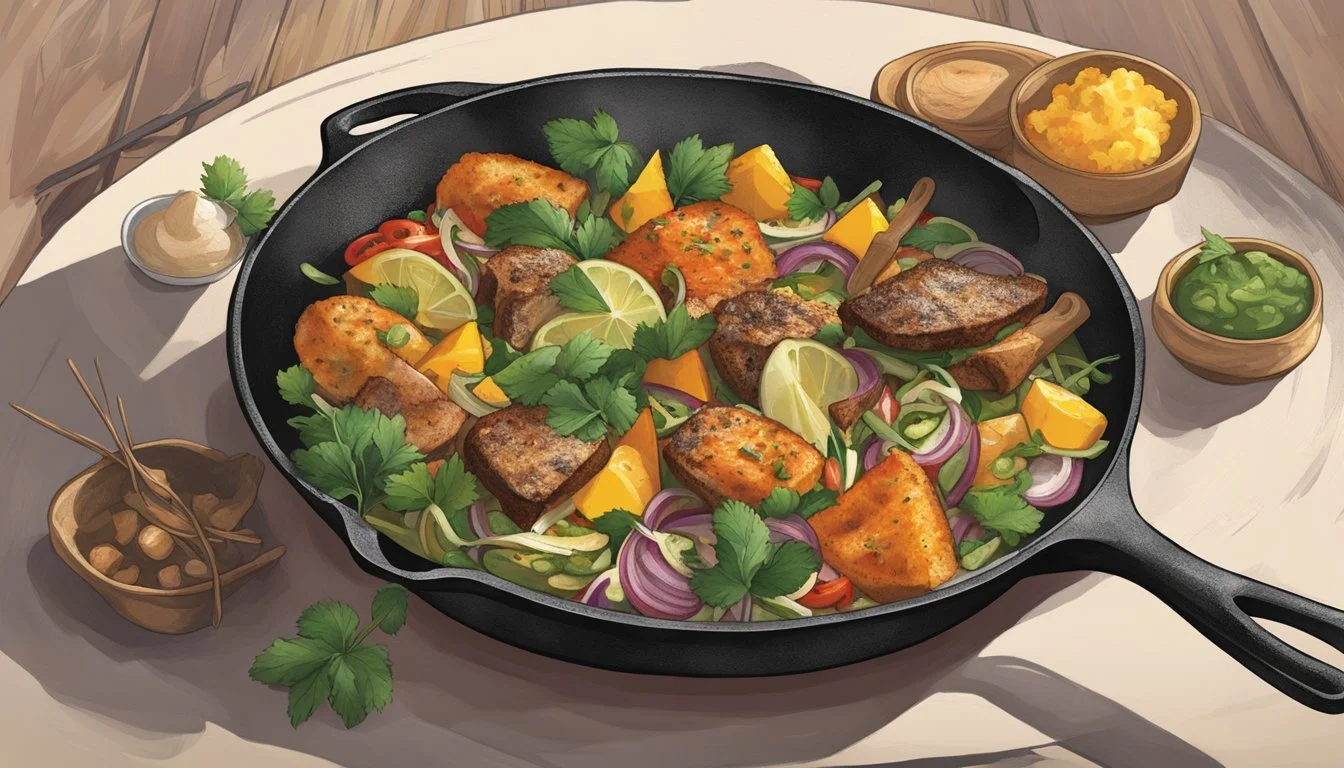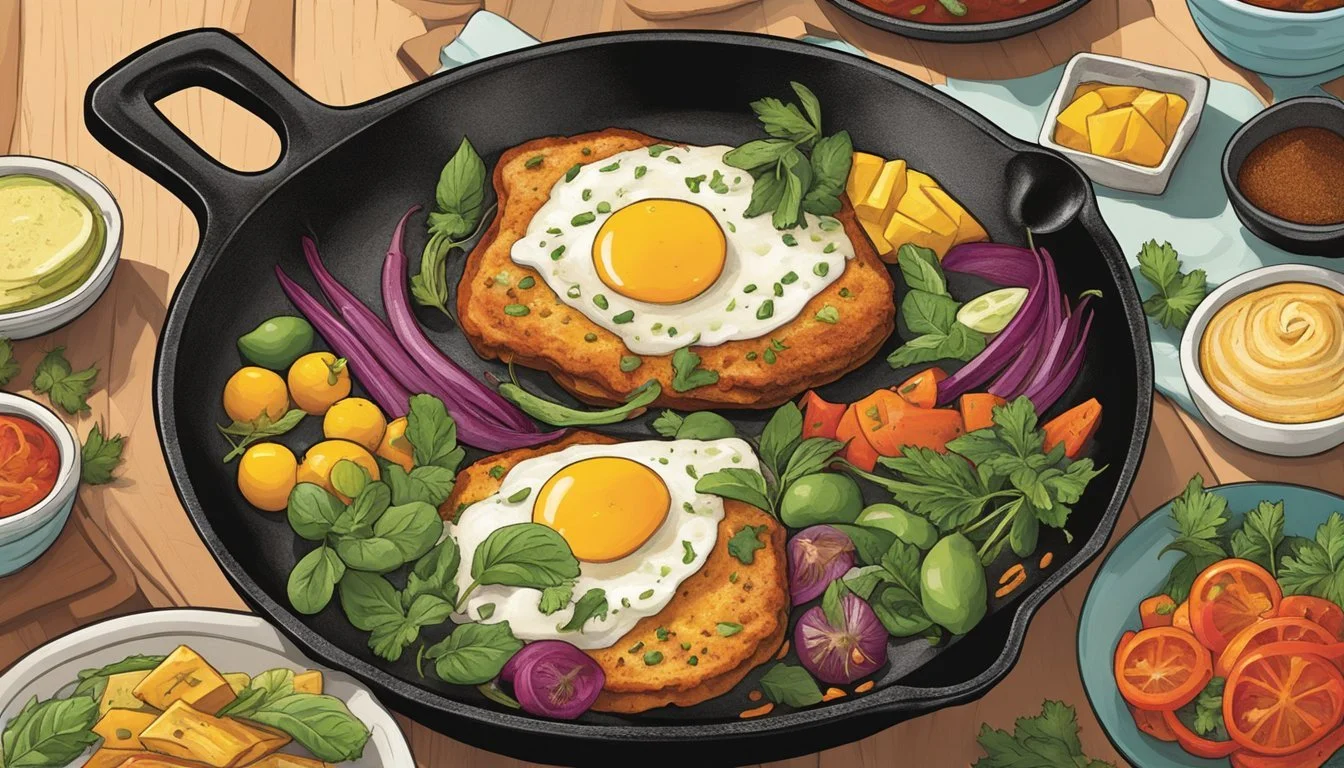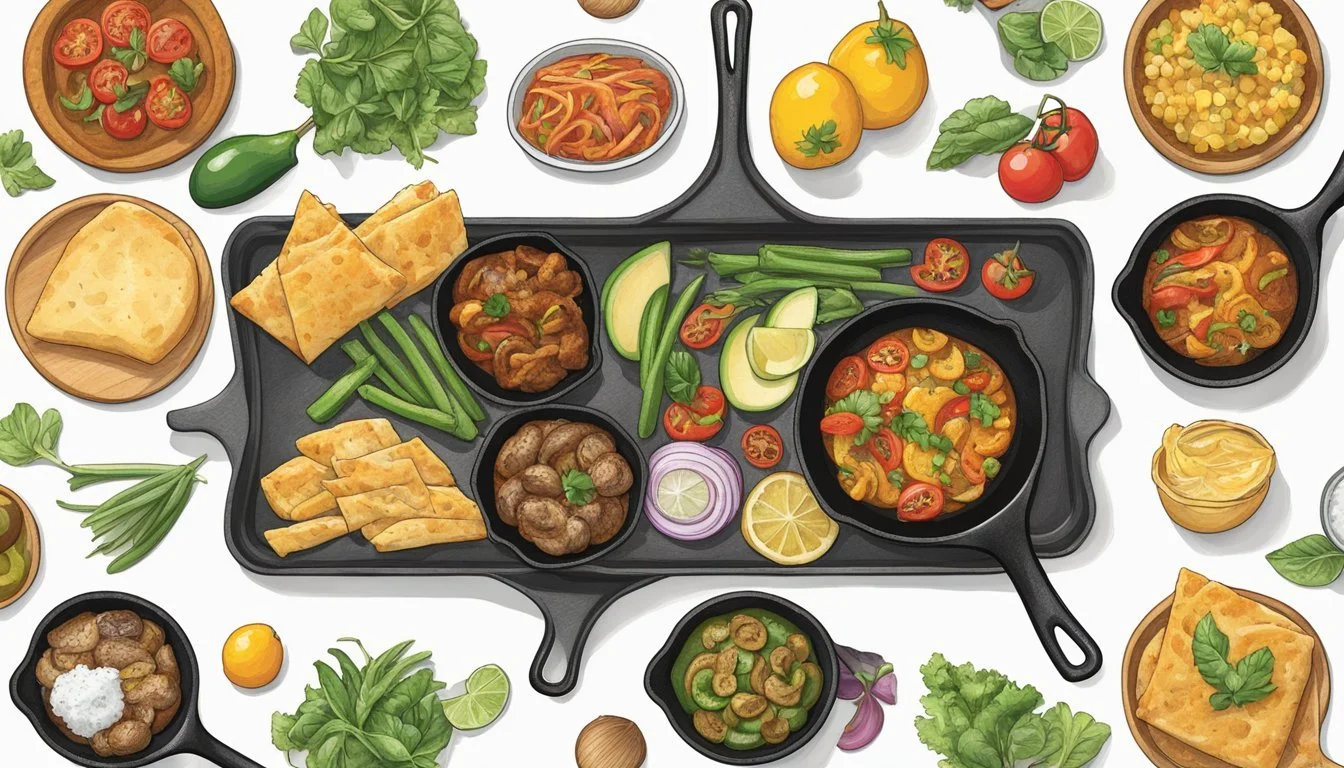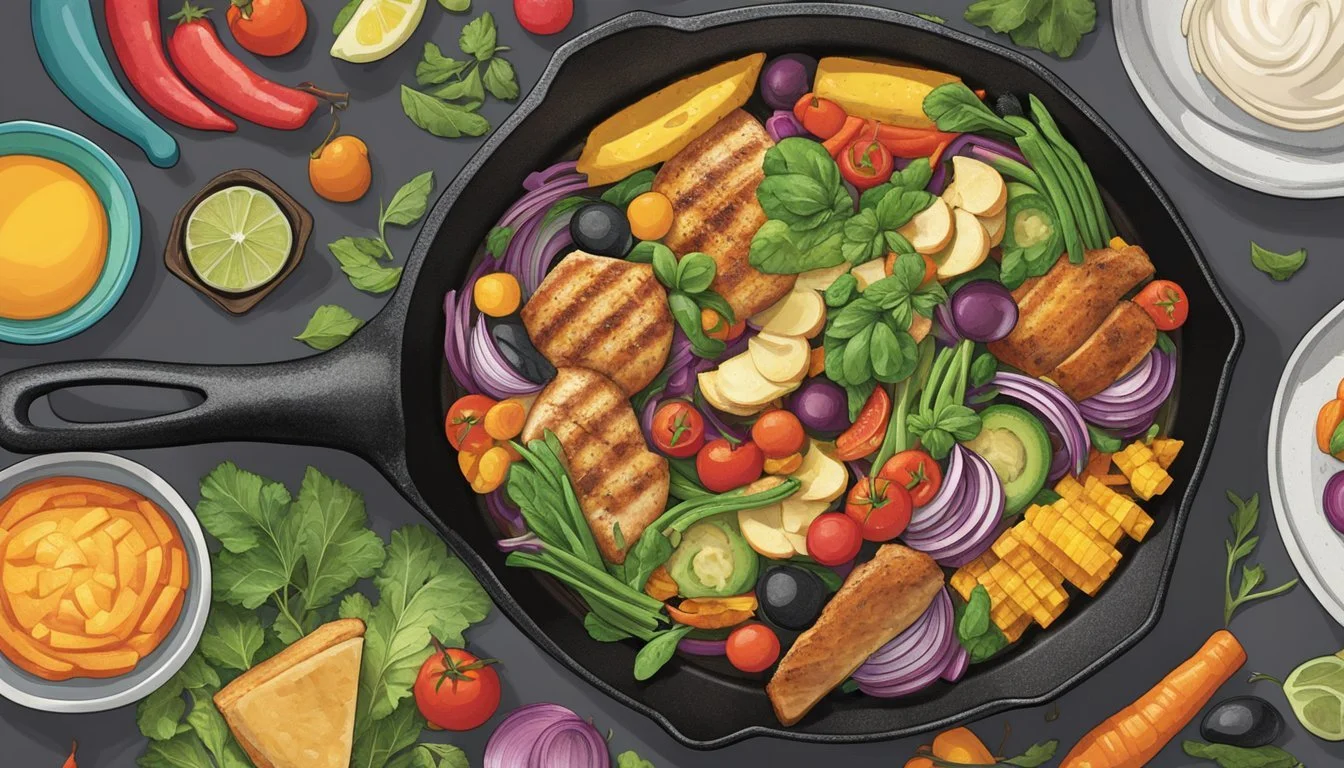Cast Iron Fusion
Mastering Diverse Cuisines in a Single Skillet
The cast iron skillet serves as a culinary canvas where the rich tapestry of global flavors can meld in harmonious fusion. This heavy, durable pan, with its superb heat retention, provides an ideal setting for experimenting with diverse culinary traditions. Fusion cuisine, a concept that weaves together the threads of disparate culinary practices, finds a fitting vessel in the cast iron skillet. The skillet's versatility enables chefs and home cooks to sear, sauté, bake, and roast a plethora of ingredients, bridging the gap between various cooking techniques from around the world.
As an emblem of American heritage, the cast iron skillet traces its roots back to the cooking tools used by Native Americans, improved upon by European settlers and further shaped by African culinary influences. Its even heat distribution is praised for the way it can expertly brown meats and hasten the cooking of vegetables, all while maintaining the integrity of the flavors. In the realm of fusion cuisine, this means a single skillet can be the medium through which a traditional Italian pasta can host a symphony of Asian flavors, exemplifying the beauty and creativity of cultural convergence in the kitchen.
The kitchen, often referred to as the heart of the home, is increasingly becoming a place of innovation where time-honored culinary traditions are being blended with modern sensibilities. The humble cast iron skillet is at the forefront of this movement, enabling the exploration of taste and tradition within its seasoned sides. As fusion cuisine continues to evolve, it is the simplicity and reliability of the cast iron skillet that anchors it in the practicalities of everyday cooking, allowing anyone to partake in the ongoing dialogue of flavors that travel from skillet to plate.
Cast Iron Fusion embodies the perfect harmony of tradition and innovation, offering a delightful culinary experience. From the rich tapestry of cast iron cookware history to the contemporary lifestyle of cast iron modern living, this fusion celebrates the timeless allure of cast iron while embracing modern culinary trends.
The art of Dutch oven cooking exemplifies this fusion, combining traditional techniques with a modern twist to create a diverse range of flavorful dishes. Whether using full-sized or convenient mini cast iron cookware, the fusion of old and new allows for the crafting of intimate meals that cater to a variety of culinary preferences, including delightful vegetarian and vegan cast iron creations.
As a thoughtful and enduring choice, a cast iron wedding gift can symbolize the strength and longevity of a couple's relationship, offering a versatile and cherished tool for every culinary adventure shared. Whether it's the charm of cast iron roasting or the convenience of mini cookware, Cast Iron Fusion seamlessly blends the best of both worlds, creating a culinary experience that is both timeless and contemporary.
The History of Fusion Cuisine
Fusion cuisine is the innovative blend of culinary traditions from different cultures, resulting in unique and flavorful dishes. This culinary movement has been shaped by historical events such as migration, global trade, and the intermingling of cultures.
Cultural Intersections in Cooking
Culinary fusion can be traced back to ancient times when the Silk Road served not only as a trade route for goods like saffron and cardamom but also as a conduit for cultural exchange, especially in cooking. Due to these intersections, local cuisines began incorporating foreign elements, leading to early instances of fusion cooking.
Influence of Migration on Food
The global movement of people through migration has been a pivotal driver in the development of fusion cuisine. As individuals relocated, they brought their culinary traditions with them, often adapting dishes to incorporate local ingredients or satisfy new palates. This resulted in novel culinary creations that have stood the test of time and symbolize the merging of culinary worlds.
Impact of Globalization and Trade
The age of colonization and the rise of global trade networks continually introduced exotic ingredients and cooking techniques to different parts of the world. The modern era of global influences further accelerated this trend, where the ease of travel and communication brought distant culinary practices into close contact. Globalization not only diversified dining tables around the world but also encouraged chefs to explore creating dishes that blended these varied food traditions, cementing the status of culinary fusion in contemporary cuisine.
Understanding Cast Iron Cookware
Cast iron cookware stands as a testament to traditional cooking methods that have withstood the test of time, offering reliability and versatility. Its notable benefits include even heat distribution and heat retention, which are central to its performance in the kitchen.
Basics and Benefits of Cast Iron
Cast iron cookware is recognized for its consistent heat distribution and exceptional heat retention, making it an excellent choice for searing meats and frying various foods. These skillets often come pre-seasoned, which means they have a layer of baked-on oil that creates a non-stick surface.
Key benefits include:
Durability: Cast iron is incredibly robust and can last for generations if maintained properly.
Versatility: Suitable for stovetop cooking, oven baking, and even outdoor grilling.
Improved Flavor: The more it's used, the better the seasoning becomes, which enhances the flavor of the food.
Iron Fortification: Cooking with cast iron can increase the iron content of food, beneficial to people with iron deficiency.
Maintenance and Care for Longevity
Proper maintenance ensures the longevity of cast iron cookware. Cleaning should be done while the pan is still warm using hot water and a soft brush or sponge to preserve the seasoned surface. Soap is generally discouraged as it can strip away the seasoning, but mild soapy water can be used occasionally if followed by thorough rinsing and heating to dry.
Maintenance steps:
Rinse with warm water after use; use mild soap if needed.
Avoid abrasive materials like steel wool that can damage the surface.
Dry immediately to prevent rust.
Apply a light layer of oil after cleaning to maintain the seasoning.
Despite its rustic image, cast iron needs careful handling, particularly when it comes to cleaning and preserving the seasoning that builds its non-stick qualities over time. Regular care maintains its cooking efficiency and ensures that it remains a reliable tool in any culinary tradition.
Essentials of Culinary Traditions and Techniques
Each culinary tradition brings its distinct ingredients, techniques, and sensory profiles that contribute to the rich tapestry of global gastronomy. In blending these traditions, it's crucial to understand the basics that make each culture's culinary method unique.
Key Ingredients and Spices Across Cultures
Culinary fusion thrives on the palette of key ingredients and spices that define regional flavors. For instance, Japanese cuisine often employs soy sauce, miso, and seaweed, creating umami-rich dishes (What Wine Pairs Best with Umami-Rich Dishes). Indian gastronomy is notable for its use of a variety of spices like turmeric, cumin, and cardamom, which offer warmth and depth of flavor. Mediterranean cooking relies on olive oil, garlic, and herbs like rosemary and thyme to achieve its signature zest. Below is a cross-cultural comparison of staple ingredients:
Culture Staple Ingredients Prominent Spices/Herbs Japanese Soy Sauce, Miso, Seaweed Wasabi, Ginger, Shiso Indian Lentils, Rice, Ghee Turmeric, Cumin, Cardamom Mediterranean Olive Oil, Garlic, Tomatoes Rosemary, Thyme, Basil
Popular Cooking Techniques
Different cuisines utilize a range of cooking techniques that reveal their culinary identity. Stir-frying, a technique popular in Chinese cooking, allows for speedy cooking that retains the crispness of vegetables and the tenderness of meats. French cooking often involves braising, a method where ingredients are first seared and then cooked slowly in a seasoned liquid for complex, melded flavors. The South American tradition of grilling, or asado, imparts a smoky char to meats and vegetables.
The Role of Texture and Flavor in Dishes
Texture and flavor are the cornerstones of any culinary experience. The creamy, dense texture of risotto, achieved through constant stirring and gradual liquid absorption, contrasts with the crispiness of a well-seared steak. The layering of flavors is critical; a dish may start with a flavorful base like a mirepoix in French cuisine or a sofrito in Spanish-speaking countries, building complexity deeper into the cooking process. Blending textures, such as combining creamy sauces with al dente pasta, add dimension to a dish, while a smart mix of spices can elevate the flavor profile significantly.
Fusion Cuisine: Blending for Taste and Creativity
Fusion cuisine exemplifies creativity in the kitchen, uniting disparate culinary traditions to innovate flavorful dishes. It leverages the universal language of food to craft a harmonious blend of bold and complementary flavors.
Balancing and Blending Flavors
In fusion cooking, the balance of flavors is paramount. Chefs must negotiate the taste spectrum — from sour to sweet, and bold to subtle — to ensure that no single flavor overpowers the rest. Techniques like seasoning adjustments and flavor layering are essential for achieving a palate-pleasing equilibrium.
Sour: Key in adding brightness, often through citrus or vinegars
Sweet: Offers a counterpoint to heat and tartness, with ingredients like honey or fruit
Crispy: Texture is used thoughtfully to complement softer components
Innovative Ingredient Combinations
The crux of fusion cuisine lies in its innovative ingredient pairings. Chefs might pair kimchi, a staple in Korean cuisine, with the Mexican classic taco, creating a distinctive concoction that satisfies the taste buds with its complexity.
Culinary Trend: Merging less conventional ingredients for a modern twist
Flavor Pairing: Establishing connections between traditional and novel items
New Ingredients: Introducing unfamiliar yet complementary tastes to established flavor profiles
New Trends in Culinary Fusion
The trend of culinary fusion is an ever-evolving canvas, subject to the influences of global interaction and creativity. New trends emerge as chefs experiment with a broader range of cuisines and techniques, infusing dishes with everything from high-heat wok flavors to delicate European sauces.
Diversity: Represents a mosaic of global cuisines
Modern Twist: Incorporates modern cooking techniques with traditional dishes
Culinary Trend: Embodies the dynamic nature of the global food scene
Through the use of well-considered techniques and the art of flavor pairing, fusion cuisine continues to surprise and intrigue, offering a limitless horizon for taste and creativity.
Health and Dietary Considerations in Fusion Cooking
Fusion cooking brings together ingredients and techniques from various global culinary traditions. This practice not only broadens the flavor palette but also introduces new opportunities to create dishes with enhanced nutritional profiles and caters to specific health needs.
Nutritional Benefits of Diverse Diets
A key advantage of incorporating diverse diets into fusion cooking is the potential for a more balanced and nutritious meal. For example, Asian cuisines might contribute high-fiber, antioxidant-rich vegetables, while Mediterranean dishes offer heart-healthy fats like olive oil and nuts.
Increased Variety: A broader selection of ingredients increases the intake of different vitamins and minerals.
Balanced Meals: By combining elements such as lean proteins, whole grains, and fresh vegetables, chefs can ensure each dish provides a range of nutrients.
Addressing Health Concerns with Fusion Dishes
Fusion cuisine can address health concerns while maintaining the cultural integrity of the dish. Chefs can substitute local ingredients that are fresher and more nutritious, reducing the presence of processed and potentially unhealthy components.
Health-Conscious Substitutions: Using locally sourced organic produce can result in dishes with fewer pesticides and a lower carbon footprint.
Rust Prevention: When cooking with cast iron, one must be cautious of rust; maintaining a well-seasoned skillet is healthy as it provides a chemical-free non-stick surface.
In summary, fusion cooking offers unique ways to combine health and flavor by drawing from the wealth of ingredients and traditions around the world.
Culinary Fusion in Practice: Sample Dishes
Exploring the blend of diverse culinary traditions in one skillet can lead to the discovery of innovative dishes that embody bold and complementary flavors. The practice of food fusion allows for a celebration of diversity on a plate, marrying well-loved ingredients in surprising and delightful ways.
Interpreting Traditional Dishes with Fusion Flair
The culinary landscape has been radically enhanced by combining different cultures' cooking techniques and staple ingredients. An exemplary fusion dish might feature African spices with Spanish potatoes, creating a harmonious blend that appreciates each culture's unique contributions. The classic Mexican cuisine can be reimagined by introducing Korean elements, akin to the popular Korean tacos that fuse soft tortillas with Korean-style seasoned meats.
Consider a reinterpretation of Creole dishes in a cast iron skillet: collard greens sautéed with sesame oil and a hint of gochujang, providing a rich umami and slightly bitter flavor profile. Another exciting fusion could be fried chicken, not only coated in traditional seasonings but jazzed up with soy sauce and garlic cloves, demonstrating how one ingredient can open doors to a new culinary experience.
Creating a Fusion Dish Step by Step
One begins with the cast iron skillet, a versatile tool perfect for creating fusion cuisine due to its even heat distribution and ability to go from stovetop to oven with ease. The skillet is first layered with ingredients that form the base flavors; this could be onions and garlic sautéed until fragrant.
Next, core components are added: diced tomatoes merge with sliced bell peppers and zucchini for a vegetable medley. To illustrate, a one-skillet meal might include penne pasta tossed with a tomato sauce that has been enriched with bacon, nori, and basil – a nod to both Italian and Asian cuisines, seasoned meticulously to ensure bold flavors without overpowering each distinct taste.
The final step involves carefully integrating the finishing touches that elevate the dish. A sprinkle of sesame oil can add depth, while a dollop of gochujang contributes a layered spice. Ensuring that every ingredient plays its part in the flavor symphony is key to a successful fusion dish – each bite should offer a celebration of diversity, reflecting the carefully balanced act of bringing together the best of multiple culinary worlds in one single skillet.







